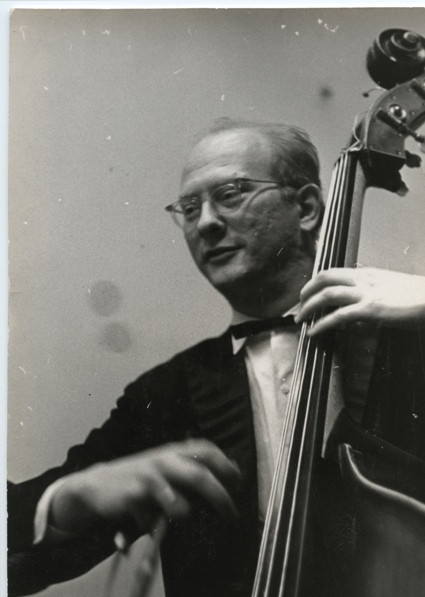
Artūrs Grīnups
(02.11.1931 - 04.12.1989 )
Artūrs Grīnups was born on November 2nd, 1931 in Riga. He studied at the 1st Riga State Secondary School, and from 1947 to 1950 in the Jāzeps Mediņš College of Music String Instrument division in the contrabass class. In 1950, he enrolled at the Jāzeps Vītols Latvian State Conservatory in the contrabass class of Vilhelms Kumbergs (1884–1956), which he graduated in 1944. Parallel with contrabass performance, he enrolled in Ādolfs Skulte’s (1909–2000) composition class in 1954, which he graduated in 1958. From 1954 to 1983 (with short breaks) he was in the contrabass group of the Latvian National Symphony Orchestra (at the time the Latvian SSR State Television and Radio Symphony Orchestra, Latvian SSR State Symphony Orchestra), as well as the concert master. From 1968 to 1977, along with his work at the Latvian National Symphony Orchestra, he was in the Latvian National Opera (at the time the Latvian SSR State Opera and Ballet Theatre) Symphony Orchestra’s contrabass group, as well as principal concert master. He died on December 4th, 1989 in Riga, and is buried in the Riga Pirmie Meža kapi Cemetery. As opposed to the majority of other Latvian composers, A. Grīnups rarely ever composed for the principal genres of vocal music – choir and solo voice. The dominating genre in his work in all his creative periods has been the symphony (altogether nine symphonies, as well as symphony for string orchestra and the work Quasi una sinfonia), along with other symphonic and instrumental chamber music works. The secret of the uniqueness of the composer’s musical handwriting is found in the gradually developed ability to combine the last third of the 19th century and the beginning of the 20th century’s brilliant late romanticism musical expression of the composers’ of that era, as well as its characteristic range of expression and magnificent impressionistic orchestra sound potential with the musical recording varied topicality of the era, which was inclined to transform all the previous experiences to a new, previously non-existing model. In those searches A. Grīnups always gave the preference to not simply intonatively satisfactory concrete, easily understood and decipherable composition of music, but also such an imagery that metaphorically at many angles was able to reflect the secretive process of psychological understanding of personal experiences. The composer’s creative work development is shown in three periods, in which successively and with an indefatigable consequence he created his own individual style. The first period is fairly short – lasting from the end of the 1950s to the beginning of the 1960s. The first five symphonies are composed and other genre works in this period, among which are many vivid works (the Third and Fifth Symphony Kaugurieši, the suite Prieks [Happiness]), as well some less interesting works. The second period from the beginning of the 1960s until the beginning of the 1980s indicates an understanding of colour addressing neo-classicism stylistics and aesthetics. That is proven by such masterworks like the Sixth Symphony and Sinfonia per archi, as well as other many instrumental chamber music opuses. His creative work’s final period proceeds to the 1980s, when A. Grīnups gradually creates his swan song – the Ninth Symphony, which is valued as the composer’s unique musical expression quintessence. A. Grīnups was well known to his contemporaries with his sharp tongue and difficult disposition. That was one of the reasons why the composer rarely experienced any positive words from the at the time Soviet occupation power and official music critics (the only attempt to pay off the obligatory occupation regime, which did not have notable publicity or praise from the official critics was the song Kā Ļeņina sardzē [In Lenin’s Guard], with text by Gunārs Selga, composed in 1967 for voice or choir with piano). The consequences of that were that none of the symphonic works of A. Grīnups were released until recently, the scores were kept in the Latvian National Library in the music division archive material fund. A. Grīnups’ unusual personality was well characterised by these two statements by his contemporaries. Pēteris Plakidis: "He was fanatically obsessed with his plans and hopes. He was constantly torn by some inner conflict, persistently unsatisfied with himself. He attempted to curb his own volcanic temperament with strong classicism chains. It could be said that his own self-flagellation and curbing was the perpetual state of his soul." Imants Zemzaris: "Artūrs Grīnups had no predecessors in Latvian music, no equals, he was not in rivalries or competition. He worked alone in his own sovereign world, as if scattered in time and space."
Jānis Kudiņš © LMIC, 2006
